Do you love strawberries but don’t have a lot of room to grow them? Do you pick or buy your berries every year and yearn to just grow your own?
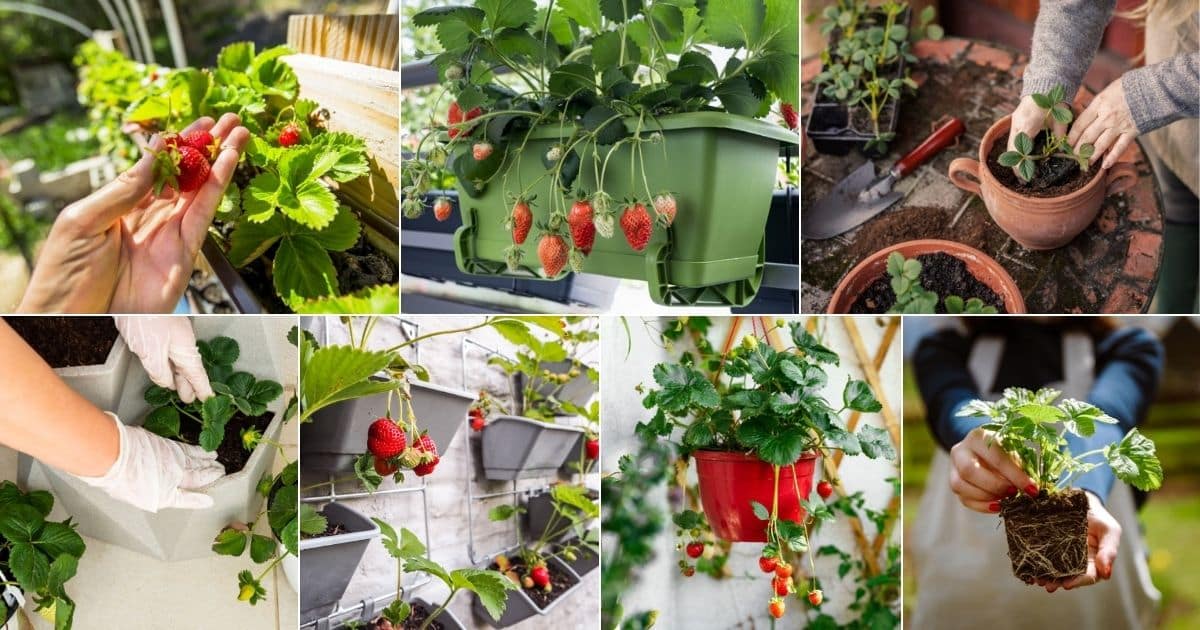
You’re certainly not alone. Who wouldn’t want their own homegrown patch of strawberries for baking, eating fresh, preserving, and enjoying as jams, jellies, and more?
The good news is that strawberries grow well in many ways. Even if all you have is a scrap of land or a bit of space on a balcony, you can grow a sizable strawberry harvest. Here’s how.
Jump to:
- First, Plan for Planting – How Many Strawberry Plants Will You Need?
- 10 Ways to Grow Strawberries in Small Spaces
- 1. Grow Strawberries in Containers
- 2. Grow Up
- 3. Grow Down
- 4. Strawberry Plant Stackers
- 5. Strawberry Towers
- 6. Grow Strawberries in Gutters
- 7. Grow Strawberries in Raised Beds
- 8. Strawberry Pyramids
- 9. Use Strawberries in Edible Landscaping
- 10. Grow Everbearing Strawberry Varieties
- Keys to Success for Small Space Strawberry Growing
First, Plan for Planting – How Many Strawberry Plants Will You Need?
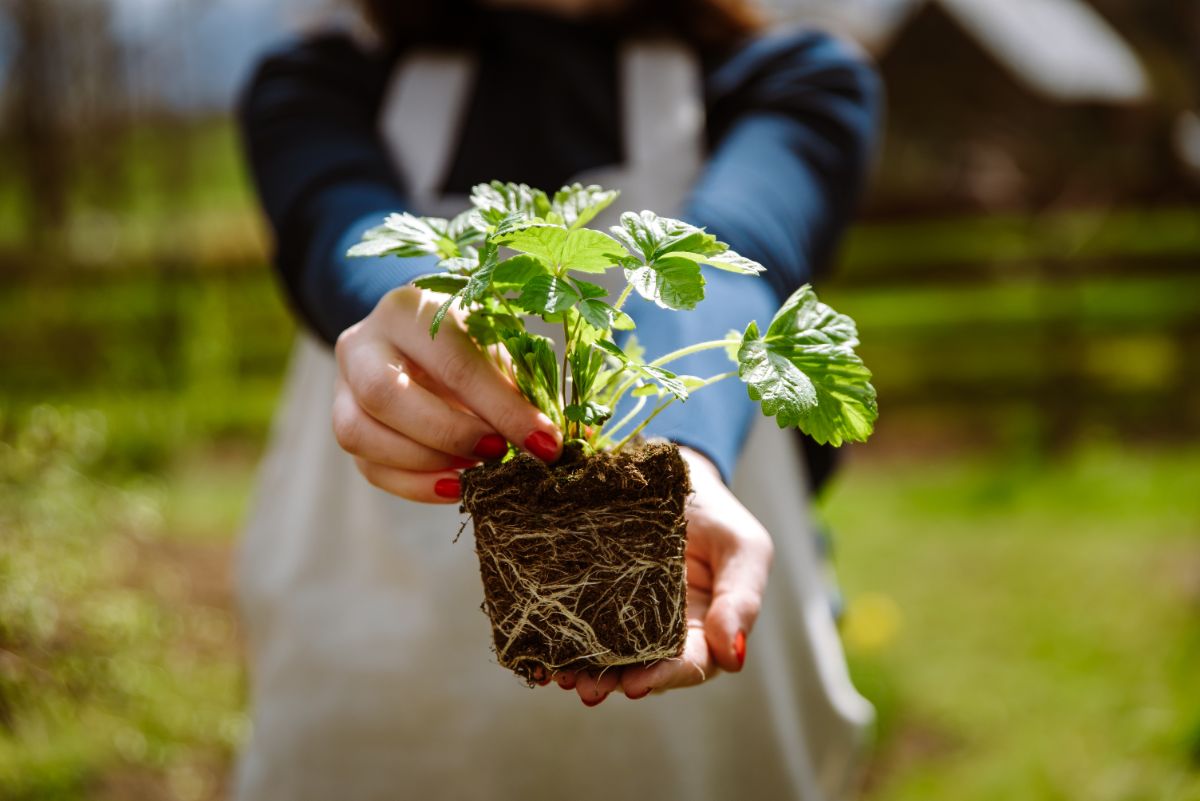
To make sure your efforts are worthwhile—ergo, that you can reap enough of a harvest to use your limited space for strawberries—it helps to have an idea of what you can expect for a yield and how many strawberry plants you’ll need to get at least a minimum harvest.
On average, you can plan to harvest one quart of strawberries per plant per season. This is generally true of both June-bearing and everbearing strawberry varieties. The difference is when you get to that one-quart figure. You’ll get them all at once with June-bearers and over the course of the summer with everbearing.
How many plants you need depends on what you want to do with your strawberries—do you just want berries to eat fresh, or do you plan to preserve some or most of your strawberries for eating later by drying, canning, or freezing?
- For mostly fresh eating: plant six or seven plants per person for fresh eating throughout the strawberry season
- For preserving: plant 10 plants per person
- For preserving and eating fresh: if you want to do both, combine and pick a number–15 to 17 plants per person would be a good, solid supply of strawberries for eating fresh in-season and preserving if you have the space to do it, but in a small-space situation that can be hard.
- Total for a Family of Four: For a household of four, your total planting would be a number between 24 and 60 plants, depending on the intended use
Given that we’re talking about growing strawberries in limited space, you may need to find a happy medium, but even in a small space, with the recommendations we have below, you can easily grow a minimum of 20 to 50 plants, so hitting these numbers is not outside the realm of possibility.
In-ground and bed planting, strawberry plants can be planted as close as 12 inches (one foot) apart. Plants can be planted in a double row (though for everbearing varieties, single rows are better). So, in the space of two feet by ten feet (2×10 bed), you can grow 20 plants. However, strawberries do not have deep root systems, so you can use alternative planting methods to grow a lot of plants in an even smaller space by using one of the methods below.
10 Ways to Grow Strawberries in Small Spaces
Here are some different ways that you can grow strawberries, even if you don’t have a lot of ground space. Keep in mind, as you read through this list, that you can also mix and match options to achieve the level of growing you want or need.
1. Grow Strawberries in Containers
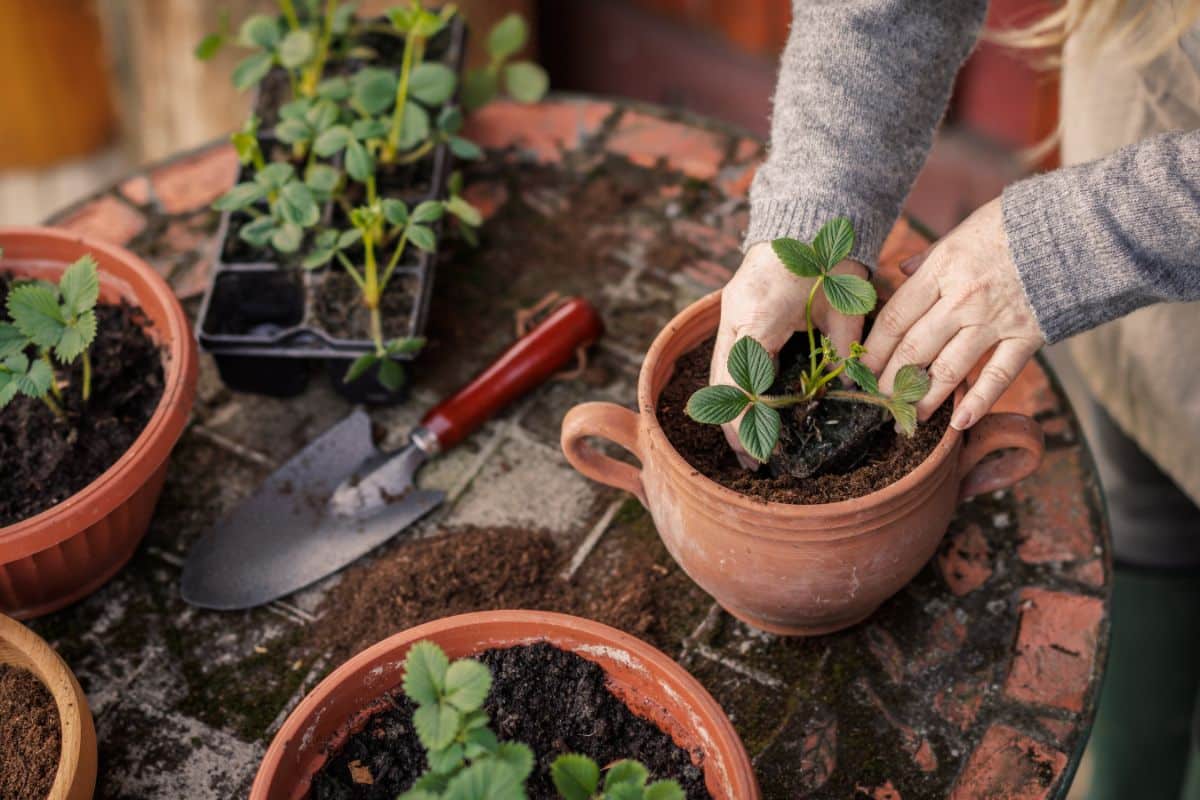
As shallow-rooting plants with low demands, strawberries are great container garden candidates. This can be as simple as growing in a classic plant pot. Six to eight inches in diameter is the minimum pot size for growing strawberries in containers; you can double the plants in large pots (for example, two strawberry plants in a 12 or 16-inch pot).
2. Grow Up
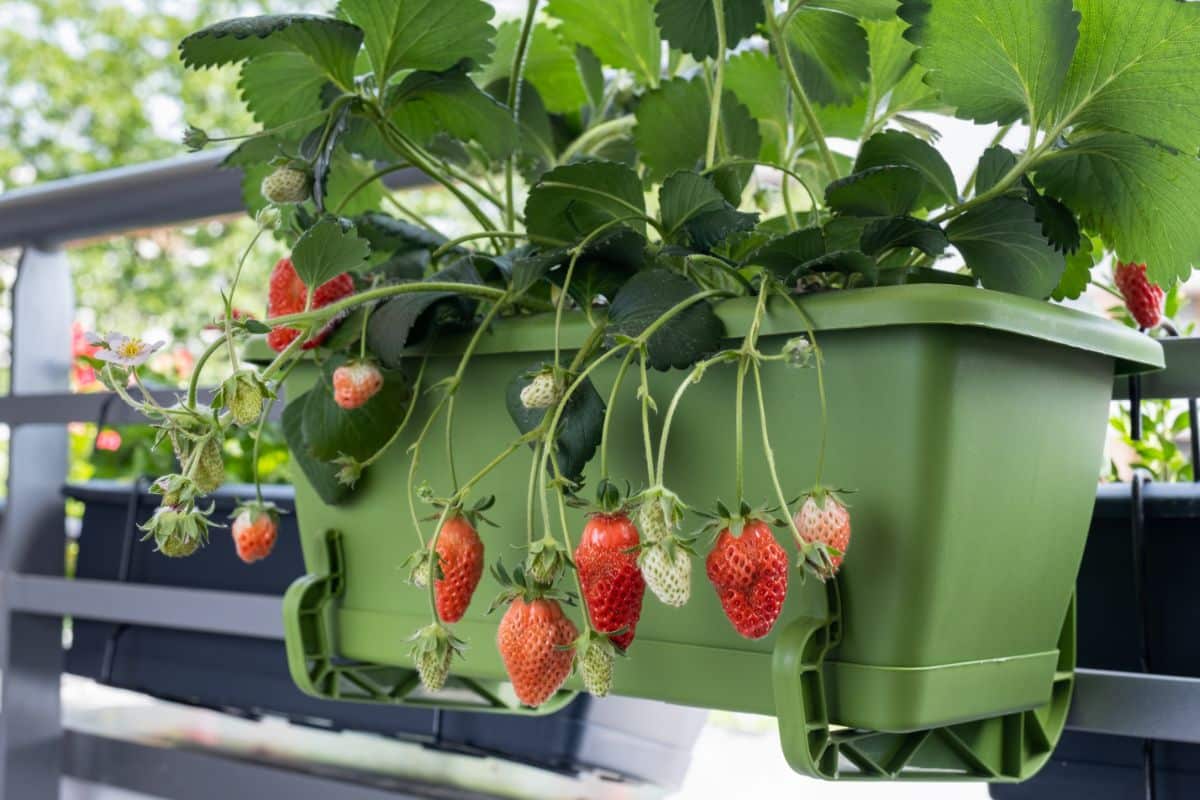
You don’t need a lot of ground or porch, or patio space if you grow up. Instead of spreading out your strawberries over a large patch of ground, use a small (almost tiny) square footage to place an upright growing system on.
In fact, you don’t need floor or ground space at all with some systems—you can grow up on a wall, hook, or railing. A window box or rail-mounted planting box is a great place for pretty, productive strawberry plants. Don’t have a railing or window for a box? Not a problem—there are some excellent innovative growing products out there perfectly suited to strawberries.
There are several more examples below that capitalize on the idea of growing up.
3. Grow Down

Strawberries grow on long stems which will hang down if the plants are suspended. They grow trailing runners, too, which will also drop down (though you’d probably do best to snip these off and root them for more plants). This ability to trail and hang means that strawberries can be grown in hangers.
Hanging baskets (like what you would grow flowers in) are one option. “Upside down” hangers like topsy-turvy planters and growing bags that can hold multiple plants down the sides are both good options, too.
4. Strawberry Plant Stackers
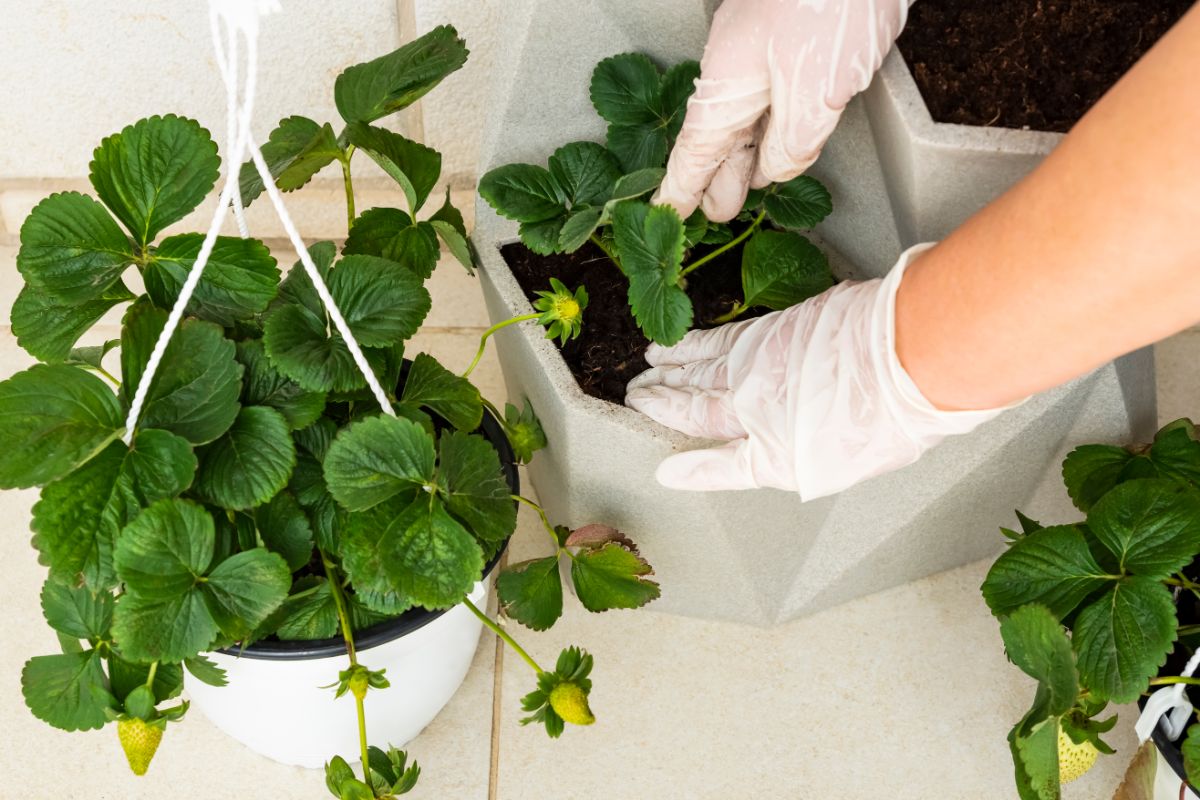
These stackable planters are becoming all the rage among container gardeners. And for good reason.
Stackable planters have separated but conjoined pot spaces. They let you grow all the same type in one pot, or you can grow a different type of plant in each pot space. Each stacking layer usually has four “pots.” The connected layers are then stacked in an offset pattern that maximizes growing in a small space. These are perfect for upright strawberry gardens.
Some types of strawberry stacker planters can be made into hanging units. Some have wheels, so they are easy to wheel indoors in winter, or to move outside in the growing season as needed, without heavy lifting.
5. Strawberry Towers
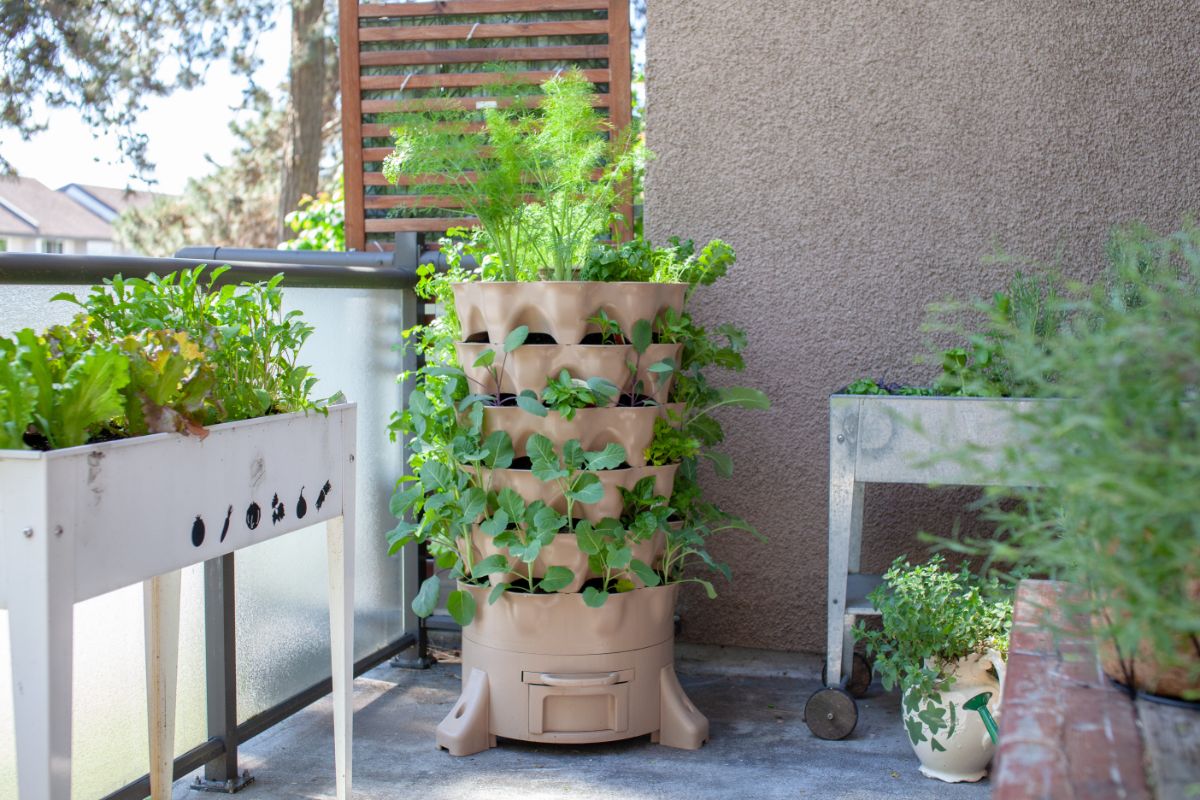
Plant towers are similar to stacker planters, but instead of having multiple pots to fill and stack, the unit is one tall, round cylinder with holes drilled at intervals around the tube and up the sides. Each hole can hold one strawberry plant.
A three-foot strawberry tower can hold up to 30 plants. That’s enough for preserving for three people. Two towers should give a family of four or five all the strawberries they need for both fresh eating and preserving.
You can buy premade strawberry towers online, or you can make your own with a piece of large PVC pipe and a hole saw drill bit.
6. Grow Strawberries in Gutters
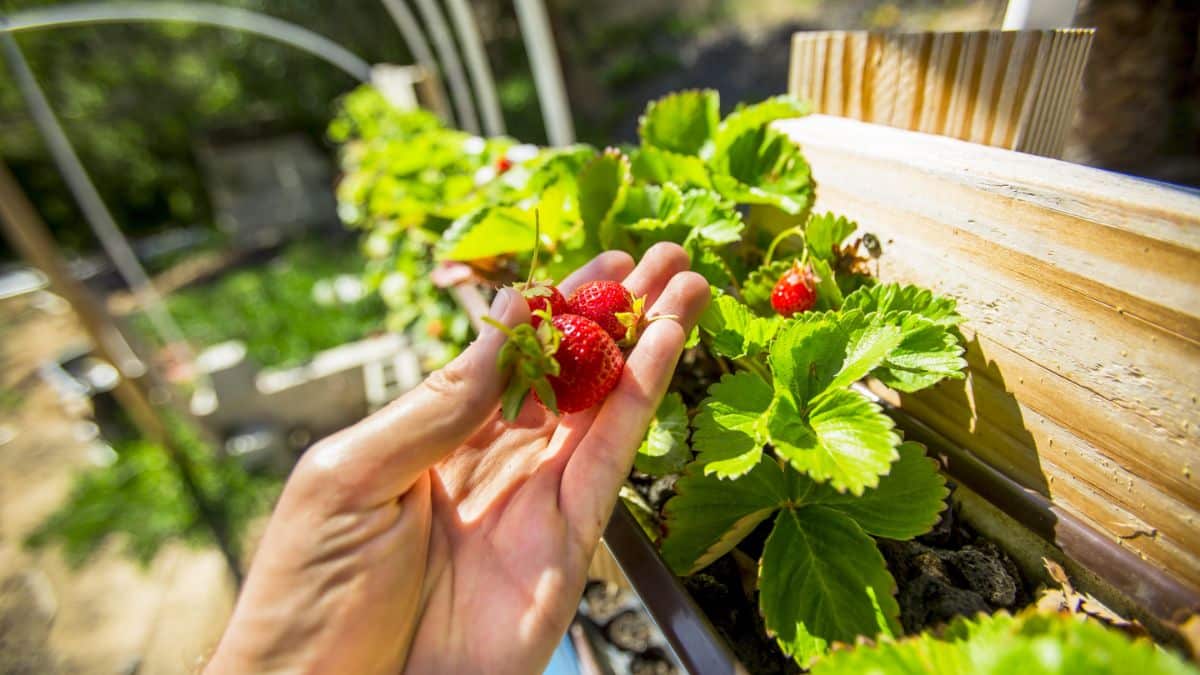
This planting idea started making the rounds a few years ago. Planting strawberries in gutters (like the kind you would install along a roof line to move the rainwater away from your roof edges) gives you a lot of linear space without any ground at all.
Strawberry gutters are usually installed on vertical walls. You can put a length of gutter about every 18 inches, going up, for as high as you can reach. At 12-inch plant spacing, an eight-foot section of gutter in three tiers will give you room for about 24 plants, yielding around 24 quarts of strawberries per year.
7. Grow Strawberries in Raised Beds
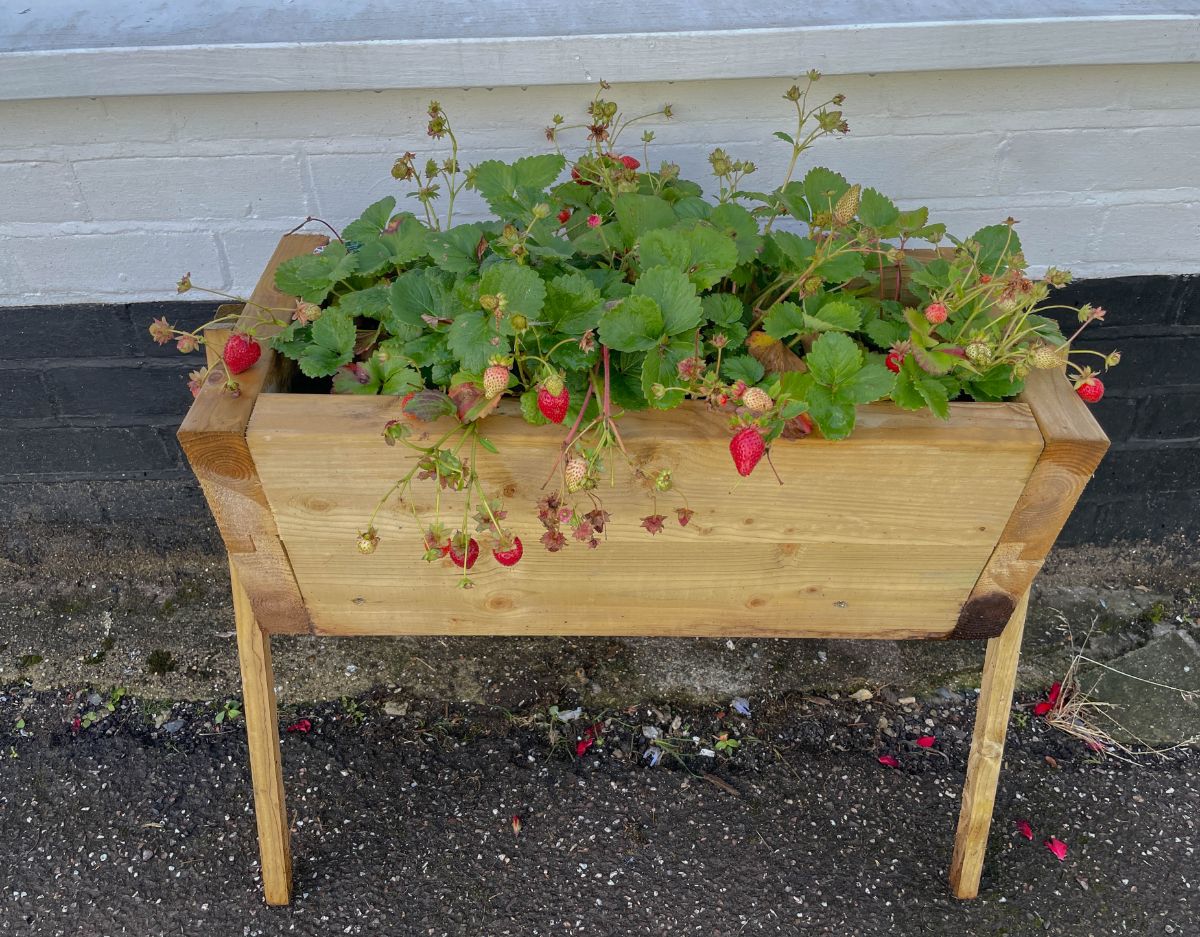
Raised beds are a great way to grow strawberries. And while you may be thinking that raised beds still take up square footage and may not solve your ground space issues, keep in mind that raised beds do not have to be set on the ground. They can be raised up on legs or placed in an area where nothing of value can grow—for instance, in a rocky patch of ground or in an area with heavy, clay soil or sandy spots that can’t grow anything.
You can even build a raised strawberry bed on a porch, patio, or balcony. And since strawberries have shallow roots, your bed will not need to be very deep; thus, it won’t require a lot of filler or soil and won’t be as heavy as raised beds for deep-rooted plants and vegetables.
8. Strawberry Pyramids
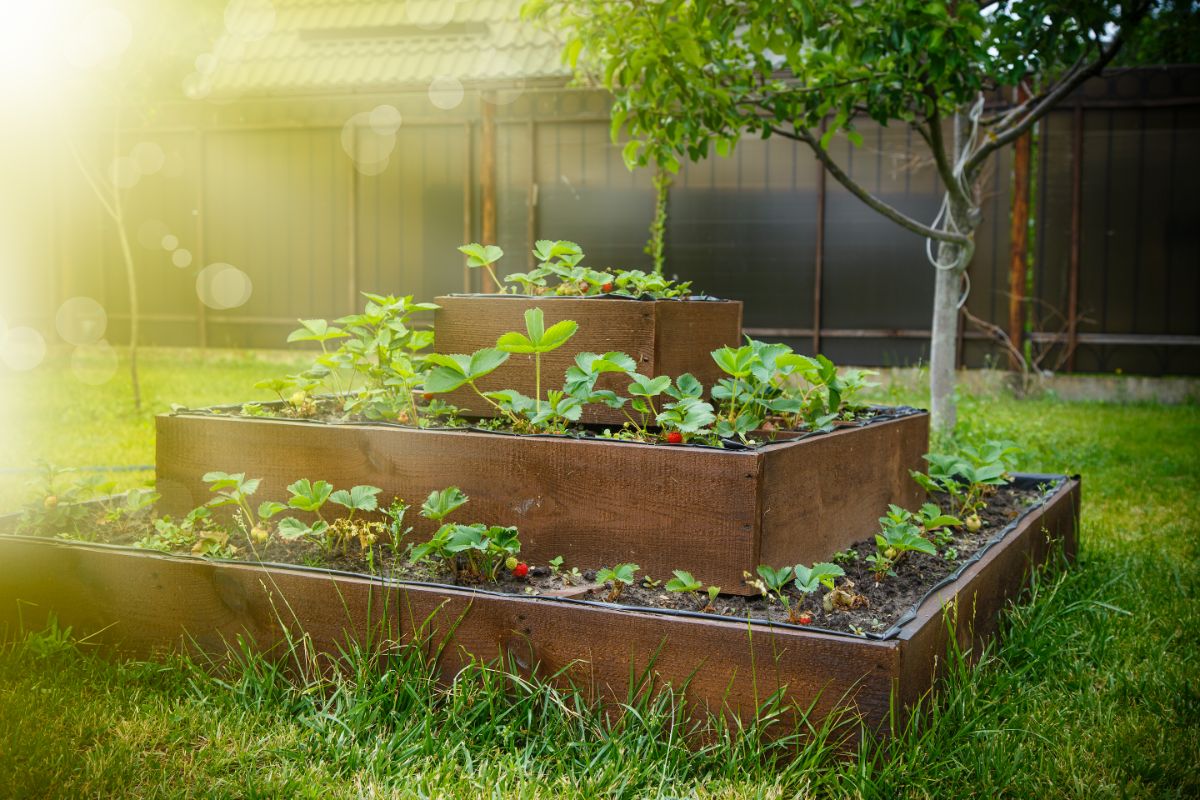
Strawberry pyramids are basically a type of raised bed or tower system, depending on which style you choose.
The original strawberry pyramids consisted of a slightly raised bed on the ground with smaller, concentric rings for the next two levels. This builds a depth of soil but utilizes the inner space while maintaining proper plant spacing and airflow.
Strawberry pyramids are an example of combining the idea of a raised bed with a “growing up” method. Burgess offers a simple kit made from corrugated metal that you unroll, then fill, then do the same for layers two and three (click the strawberry pyramid link above). The first layer is six feet in diameter, the second three and a half, and the third is two feet. In just six square feet of space, you can grow as many as 50 strawberry plants—enough for a family of five!
You can even install a hose and sprinkler that comes up through the top middle of the pyramid if you think you will need to water your strawberry patch frequently.
If you are even a little bit handy, you can easily build your own DIY strawberry pyramid. You’ll find plenty of plans online.
9. Use Strawberries in Edible Landscaping
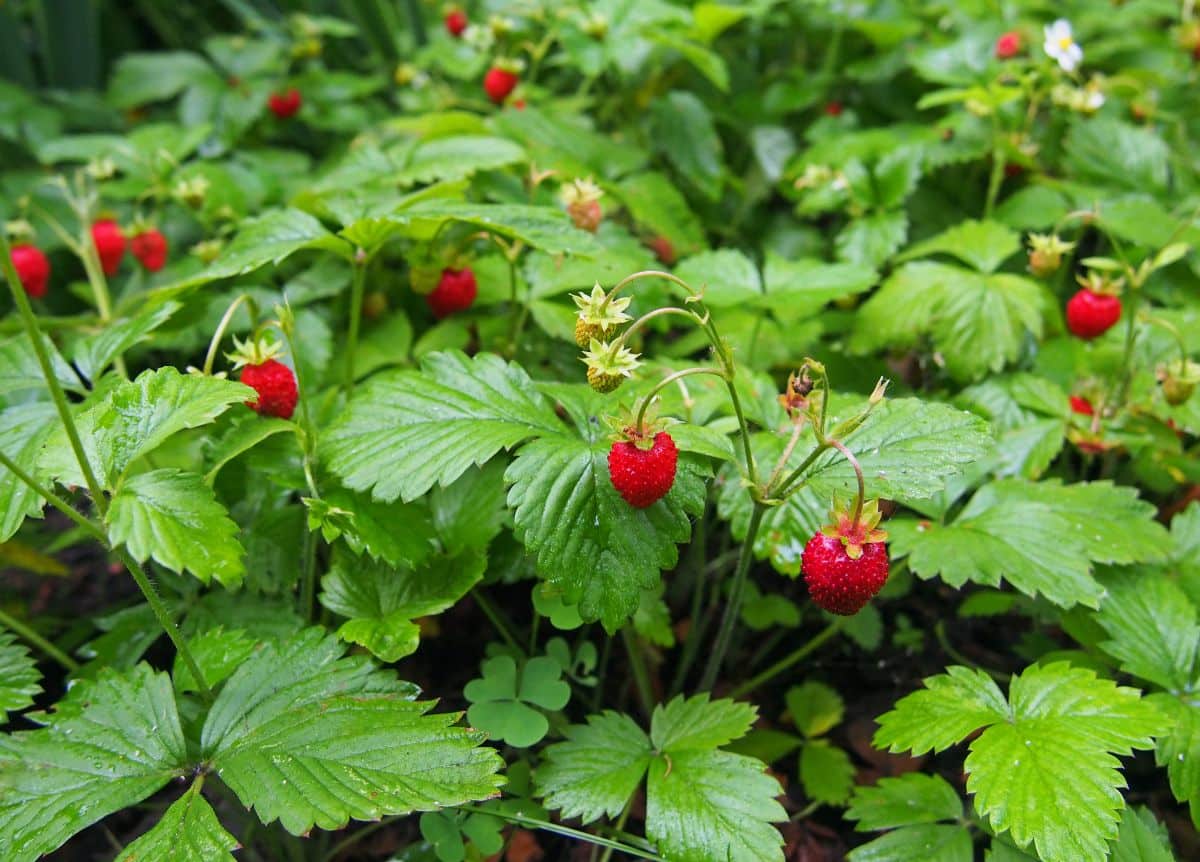
Here’s something not everyone knows—strawberries, especially June-bearing types that send out lots of runners, make an excellent ground cover. This means they are ideal for incorporating into an edible landscape garden. Why waste that space on plants that are purely aesthetic, when you could be reaping a harvest of sweet strawberries?
Strawberries do, in fact, grow well alongside many ornamental plants and flowers, too, including below and around bushes. They have attractive green foliage and sweet little flowers when in bloom. So, you don’t really need to have one or the other–you can enjoy both!
10. Grow Everbearing Strawberry Varieties
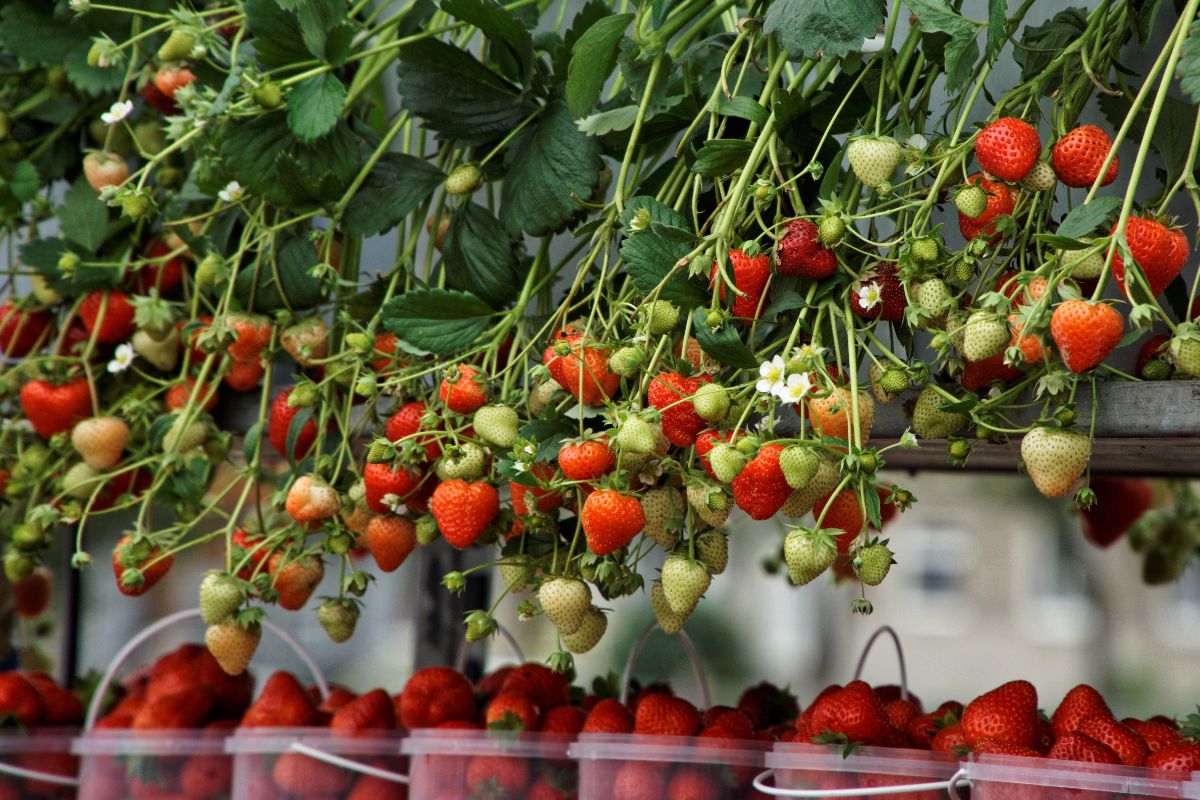
While it is true that the overall yield from June-bearing strawberries and everbearing strawberries is similar, in a small-space situation, everbearing strawberries are often better. They produce for a long period over most of the growing season. They don’t grow many runners, which means it is easier to keep them contained and maintained, and they put most of their energy and resources into berries.
Strawberries in containers are often grown on patios and porches and can be protected a bit easier than those in the ground, so you can also extend the growing season a bit longer, which can help to bump up your overall yield.
For the steadiest and best yield all summer long, choose everbearing strawberries that are listed as “day neutral.” These varieties do not respond to day length, so as long as they have enough light, warmth, and care, they can keep producing as the days get longer or shorter.
Keys to Success for Small Space Strawberry Growing
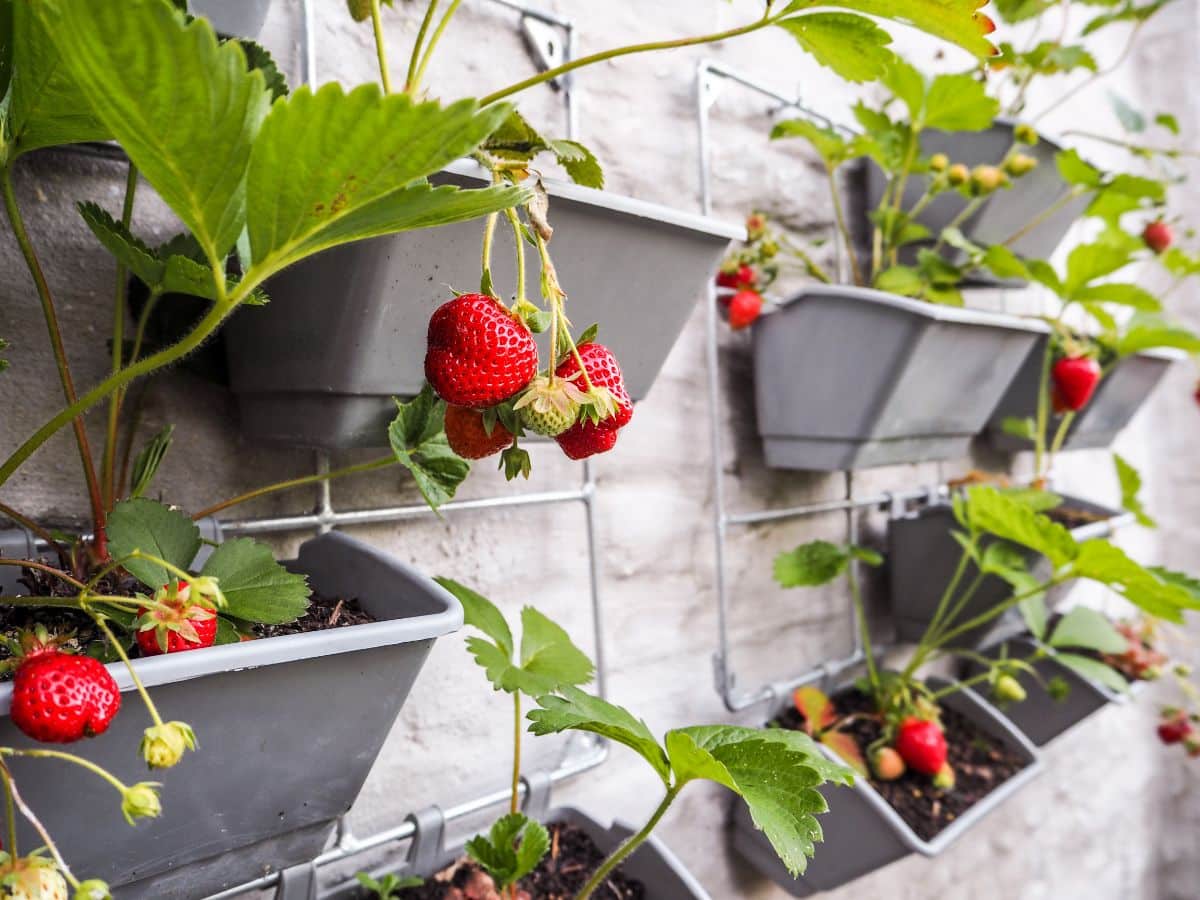
The keys to success with growing strawberries in smaller spaces are not very different than the keys to growing in large garden beds:
- Space plants appropriately, with 12 to 18 inches of space in between
- Don’t overcrowd containers, pots, or towers; disease from overcrowding is a leading cause of strawberry failure
- Allow for adequate air circulation to prevent disease
- Avoid dark-colored planters that will absorb heat and keep soil and roots too warm in summer
- Pull, prune, or dig out daughter plants from runners when the planter or planting area gets too crowded—thinned plants can be used to create new growing beds or spaces
- Use quality, loamy, well-draining soil—you may mix heavy soils with sand to increase drainage, but be sure there is plenty of organic matter, too
- Amend and prepare the soil for planting a couple of weeks before planting
- In containers and gutters, potting soil is best—it won’t compact too much
- Follow recommended fertilization schedules, and don’t fertilize too close to fruit set, or fruit will be mushy
- Water regularly, do not let plants dry out, but be careful not to overwater and invite disease
- Plan for overwintering, especially for shallow planters like gutters and container plants that need extra protection (pots and containers will freeze more quickly and more thoroughly and risk root damage; for best results, cover and overwinter them in a garage, shed, or greenhouse)









Leave a Reply